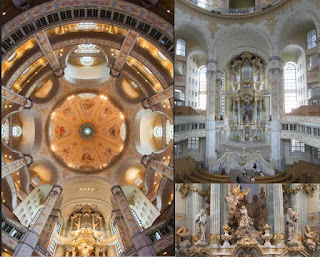Dresden--The Rebuilt City
The recent, distressing fire at Notre Dame de Paris provided an interesting backdrop for my trip with my friends across the border to the German city of Dresden.
Having visited Dresden for its famous Christmas markets, I was looking forward to spending more time exploring the Old Town (Altstadt), full of beautiful Baroque buildings made from carved sandstone, arrayed along the Elbe River.
But, if non-Europeans know anything of Dresden, they probably know that it was the target of a several days of intense firebombing by the US and British Air Forces at the end of World War II--the same campaign that saw Prague accidentally bombed and portions of the Emmaus monastery destroyed. How did this historic city survive?
It didn't.
After nearly a thousand bombing runs, the city of Dresden was effectively razed, including almost all its historical splendor. 25,000 people are estimated to have been killed, and roughly 90% of the city center was utterly destroyed. Though often overshadowed in the US by the atomic bomb attacks on Hiroshima and Nagasaki a few months later, the Dresden attacks are still highly controversial.
After the war, Dresden became part of the Orwellian-named DDR (Deutsche Demokratische Republik -- German Democratic Republic)--East Germany. The East Germans and their Soviet allies rebuilt much of Dresden. Some parts of the city were given over to the Socialist Modernist style that was popular in the Eastern Bloc. Many of the historic landmarks, however, were painstakingly reconstructed.
Then:
And now:
However, there was one landmark that they let stand in its destroyed state as a memorial to those who had died, the 18th century Dresden Frauenkirche, a classic of Protestant architecture.
It stood that way for several decades
After German Reunification, however, there was a movement to rebuild the church. Money was raised, experts were consulted, archives were searched for both materials and references, and in 1995, true reconstruction was begun. The €180 million project was financed almost entirely by private donors, and the church reopened--ahead of schedule--in 2005, a year before Dresden's 800th anniversary. Today, it dominates the city skyline and the New Market Square.
The interior is equally impressive
On my first trip to Dresden, I was ignorant enough that I didn't immediately realize that the Frauenkirche was a reconstruction. It's a beautiful place that still feels full of history, even though I have socks older than it.
And this is why I have hope for Notre Dame de Paris. Often, we bull-doze the past to make way for the future, or we feel something needs "modernizing." But we can also recreate it, down to the smallest detail, honoring both the past and the present.
Become a Patron!
Having visited Dresden for its famous Christmas markets, I was looking forward to spending more time exploring the Old Town (Altstadt), full of beautiful Baroque buildings made from carved sandstone, arrayed along the Elbe River.
 |
| As seen from across the river. |
But, if non-Europeans know anything of Dresden, they probably know that it was the target of a several days of intense firebombing by the US and British Air Forces at the end of World War II--the same campaign that saw Prague accidentally bombed and portions of the Emmaus monastery destroyed. How did this historic city survive?
It didn't.
 |
| The Aldstadt, 1945 |
After nearly a thousand bombing runs, the city of Dresden was effectively razed, including almost all its historical splendor. 25,000 people are estimated to have been killed, and roughly 90% of the city center was utterly destroyed. Though often overshadowed in the US by the atomic bomb attacks on Hiroshima and Nagasaki a few months later, the Dresden attacks are still highly controversial.
After the war, Dresden became part of the Orwellian-named DDR (Deutsche Demokratische Republik -- German Democratic Republic)--East Germany. The East Germans and their Soviet allies rebuilt much of Dresden. Some parts of the city were given over to the Socialist Modernist style that was popular in the Eastern Bloc. Many of the historic landmarks, however, were painstakingly reconstructed.
Then:
 |
| The Rampart Pavilion at the early 18th Century Zwinger Palace, 1945. |
And now:
 |
| The Rampart Pavilion as I saw it last weekend. |
Then:
 |
| Dresden Cathedral and Royal Palace, 1945. |
Now:
 |
| As seen at sunrise last year. |
However, there was one landmark that they let stand in its destroyed state as a memorial to those who had died, the 18th century Dresden Frauenkirche, a classic of Protestant architecture.
 |
| Even the statue of Martin Luther was knocked off its pedestal. |
It stood that way for several decades
 |
| The memorial in the 1980s. The statue was put back on the pedestal. |
After German Reunification, however, there was a movement to rebuild the church. Money was raised, experts were consulted, archives were searched for both materials and references, and in 1995, true reconstruction was begun. The €180 million project was financed almost entirely by private donors, and the church reopened--ahead of schedule--in 2005, a year before Dresden's 800th anniversary. Today, it dominates the city skyline and the New Market Square.
 |
| The darker stones are parts of the original building. |
The interior is equally impressive
 |
| The dome is one of the largest in Europe. |
On my first trip to Dresden, I was ignorant enough that I didn't immediately realize that the Frauenkirche was a reconstruction. It's a beautiful place that still feels full of history, even though I have socks older than it.
And this is why I have hope for Notre Dame de Paris. Often, we bull-doze the past to make way for the future, or we feel something needs "modernizing." But we can also recreate it, down to the smallest detail, honoring both the past and the present.







Comments
Post a Comment